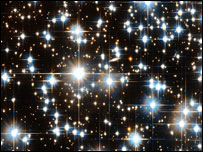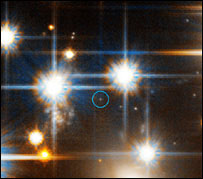
Hidden among the brilliant stars of NGC 6397 are very faint stars
|
Researchers peering at the Universe's first-born stars have uncovered the key to predicting a star's destiny. Stars that do not have enough mass never shine, dying billions of years before their bigger counterparts.
But astronomers have never been able to measure the exact mass limit, because the lightest stars that do shine can be simply too faint to detect.
Now, new images show for the first time how big a star must be to avoid impending doom.
Reporting in the journal Science, astronomers have viewed high quality pictures of some of the faintest stars in our galaxy.
The images come from the dimmest members of the NGC 6397 cluster - a close-knit group of ancient stars that orbit the Milky Way's centre.
"The light from these faint stars is so dim that it is equivalent to that produced by a birthday candle on the Moon, as seen from Earth," said lead author Harvey Richer, from University of British Columbia, Vancouver, Canada.
The Hubble Space telescope's advanced camera was focused on the stars for five days to detect the tiny pinpricks of light.
Although the telescope would have been able to detect fainter stars, none could be found - so it appears that they simply don't exist. "We checked the instruments over and over again," said Professor Richer, "but we don't see any stars fainter than this."
By calculating the mass of the faintest ancient stars, researchers can work out the minimum mass needed for a star to survive. Potential stars that fall just short of the limit die before they are even born.
Survival of the fattest
Almost everything about a star's fate is determined by the mass of the gas cloud from which it is formed.
Gravity pulls the gas into a giant ball, or protostar. As the ball gets bigger and denser, its centre becomes extremely hot.
For large protostars, the heat becomes so intense that the star begins to burn hydrogen by fusion, and so starts to shine.

Inside the blue circle is an ancient cooling white dwarf
|
Small protostars never make it this far. Their cores are just not hot enough for hydrogen fusion, so they never light up. They quickly stop shrinking and fade into brown dwarfs that are little more than giant gas planets. So, a small difference in mass can therefore mean the difference between a long life and an untimely death.
But how big is big enough? The problem has been that those stars that do start to shine - but have only just enough mass - burn very faintly and are nearly impossible to see.
The long-awaited new images finally lay this question to rest, say the authors. The dimmest stars were measured as being 8.3% of the Sun's mass. All protostars that are smaller than this are headed for life as a brown dwarf.
Star death
The pictures also provide a spectacular new record of the end of a star's life.
Large stars, which burn out more quickly, can become white dwarfs - glowing cinders which slowly fade with age. Astronomers had predicted that these should turn blue as they move towards death.
The new findings provide the first images of this signature colour change, confirming expectations.


~RS~q~RS~~RS~z~RS~45~RS~)